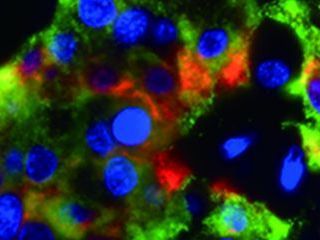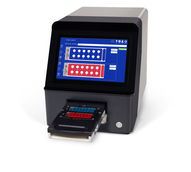Think zinc: Molecular sensor could reveal zinc's role in diseases
Advertisement
Scientists have developed a new molecular sensor that can reveal the amount of zinc in cells, which could tell us more about a number of diseases, including type 2 diabetes. The research, published in Nature Methods, opens the door to the hidden world of zinc biology by giving scientists an accurate way of measuring the concentration of zinc and its location in cells for the first time.
Zinc is involved in many processes in the body and five percent of all the proteins made by the body's cells are involved in transporting zinc. Scientists believe that zinc plays a role in many diseases; for example, it helps package insulin in pancreas cells and in people with type 2 diabetes, the gene that controls this packaging is often defective.
Previously, researchers used crude chemical techniques to get a rough idea of the concentration of zinc in cells. However, they could not produce an accurate picture of how much zinc was present in cells or where it was within them.
In the new study, researchers from Imperial College London and Eindhoven University of Technology have developed a molecular sensor using fluorescence proteins that can measure the distance between zinc ions in individual cells, showing how much zinc is present.
Professor Guy Rutter, one of the authors of the study from the Division of Medicine at Imperial College London, said: "There has been relatively little biological work done on zinc compared to other metals such as calcium and sodium, partly because we didn't have the tools to measure it accurately before now. Zinc is so important in the body – studies have suggested it has roles in many different areas, including muscles and the brain."
The new sensor, called a fluorescence resonance energy transfer (FRET)-based sensor, is made up of two jellyfish proteins called green fluorescent proteins. The researchers altered the first protein to give off light at a certain wavelength, and altered the second protein to collect that light. When the proteins attached to zinc ions, the proteins became pushed apart and the transmission of light between them became weaker. The researchers used a fluorescence microscope to detect the wavelengths of light emitted by the proteins. This revealed zinc in the cell, with coloured patches visible where the proteins detected zinc.
The researchers used their new sensor to look for zinc in pancreatic cells, where insulin is packaged around zinc ions. Previous research had suggested that in people with type 2 diabetes, the gene that controls the packaging process is often defective, affecting the way insulin is stored. The researchers found a high concentration of zinc ions inside certain parts of the cells where insulin is found. They hope their new sensor could help scientists look more closely at this to find out exactly how zinc is involved in diabetes. The researchers would now like to develop their new sensor to look at zinc in a living mouse model, so they can observe the movement of zinc in different tissues, for example in diabetes.
Other news from the department science
These products might interest you
Most read news
More news from our other portals
See the theme worlds for related content
Topic world Fluorescence microscopy
Fluorescence microscopy has revolutionized life sciences, biotechnology and pharmaceuticals. With its ability to visualize specific molecules and structures in cells and tissues through fluorescent markers, it offers unique insights at the molecular and cellular level. With its high sensitivity and resolution, fluorescence microscopy facilitates the understanding of complex biological processes and drives innovation in therapy and diagnostics.

Topic world Fluorescence microscopy
Fluorescence microscopy has revolutionized life sciences, biotechnology and pharmaceuticals. With its ability to visualize specific molecules and structures in cells and tissues through fluorescent markers, it offers unique insights at the molecular and cellular level. With its high sensitivity and resolution, fluorescence microscopy facilitates the understanding of complex biological processes and drives innovation in therapy and diagnostics.




























































